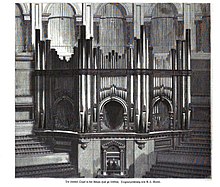
The pipe organ is a musical instrument that produces sound by driving pressurised air through the organ pipes selected from a keyboard. Because each pipe produces a single pitch, the pipes are provided in sets called ranks, each of which has a common timbre, volume, and construction throughout the keyboard compass. Most organs have many ranks of pipes of differing pitch, timbre, and volume that the player can employ singly or in combination through the use of controls called stops.

In music, the organ is a keyboard instrument of one or more pipe divisions or other means for producing tones. The organs have usually two or three, up to five, manuals for playing with the hands and a pedalboard for playing with the feet. With the use of registers, several groups of pipes can be connected to one manual.

An organ stop is a component of a pipe organ that admits pressurized air to a set of organ pipes. Its name comes from the fact that stops can be used selectively by the organist; each can be "on", or "off".

A pedalboard is a keyboard played with the feet that is usually used to produce the low-pitched bass line of a piece of music. A pedalboard has long, narrow lever-style keys laid out in the same semitone scalar pattern as a manual keyboard, with longer keys for C, D, E, F, G, A, and B, and shorter, raised keys for C♯, D♯, F♯, G♯ and A♯. Training in pedal technique is part of standard organ pedagogy in church music and art music.

A theatre organ is a type of pipe organ developed to accompany silent films, from the 1900s to the 1920s.

A manual is a musical keyboard designed to be played with the hands, on an instrument such as a pipe organ, harpsichord, clavichord, electronic organ, melodica, or synthesizer. The term "manual" is used with regard to any hand keyboard on these instruments to distinguish it from the pedalboard, which is a keyboard that the organist plays with their feet. It is proper to use "manual" rather than "keyboard", then, when referring to the hand keyboards on any instrument that has a pedalboard.

An expression pedal is an important control found on many musical instruments including organs, electronic keyboards, and pedal steel guitar. The musician uses the pedal to control different aspects of the sound, commonly volume. Separate expression pedals can often be added to a guitar amplifier or effects unit and used to control many different aspects of the tone.
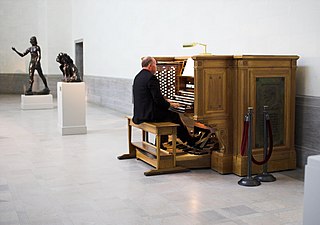
The Spreckels Organ is a pipe organ that was designed by Ernest M. Skinner. It was installed in 1924 at the Legion of Honor museum in San Francisco, California. Public performances are held on Saturdays, 4:00–4:45 pm.
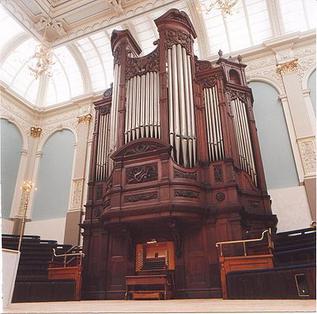
Henry Willis & Sons is a British firm of pipe organ builders founded in 1845. Although most of their installations have been in the UK, examples can be found in other countries.
N.P Mander Limited later Mander Organs Limited was an English pipe organ maker and refurbisher based in London. Although well known for many years in the organ building industry, they achieved wider notability in 2004 with the refurbishment of the Royal Albert Hall's Father Willis Grand Organ. That company filed for insolvency in 2020 with their trading name and intellectual rights being bought out by the Canterbury firm F. H Browne and Sons.
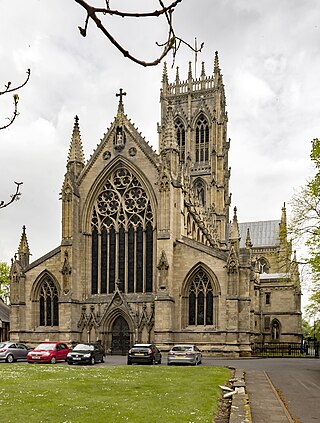
Doncaster Minster, formally the Minster and Parish Church of St George, is the Anglican minster church of Doncaster, South Yorkshire, England. It is a grade I listed building and was designed by architect designer George Gilbert Scott. The church was built in 1854–1858 to replace an earlier building destroyed by fire. It is an active place of worship and has a Schulze organ, a ring of eight bells, and a celebrated clock by Dent. The church is one of two parish churches to have minster status in South Yorkshire. The other is the minster church of Rotherham.

The Boardwalk Hall Auditorium Organ, known also as the Midmer-Losh and the Poseidon, is the pipe organ in the Main Auditorium of the Boardwalk Hall in Atlantic City, New Jersey, built by the Midmer-Losh Organ Company. It is the largest organ in the world, as measured by the number of pipes.

The pipe organ is played from an area called the console or keydesk, which holds the manuals (keyboards), pedals, and stop controls. In electric-action organs, the console is often movable. This allows for greater flexibility in placement of the console for various activities. Some very large organs, such as the van den Heuvel organ at the Church of St. Eustache in Paris, have more than one console, enabling the organ to be played from several locations depending on the nature of the performance.
Brighton and Hove has numerous notable pipe organs, from the small early 19th-century organs to the large 20th-century instruments in the large churches.
The Organ Reform Movement or Orgelbewegung was a mid-20th-century trend in pipe organ building, originating in Germany. The movement was most influential in the United States in the 1930s through 1970s, and began to wane in the 1980s. It arose with early interest in historical performance and was strongly influenced by Albert Schweitzer's championing of historical instruments by Gottfried Silbermann and others, as well as by Schweitzer's opinion that organs should be judged primarily by their ability to perform with clarity the polyphonic Baroque music of J. S. Bach (1685–1750). Concert organist E. Power Biggs was a leading popularizer of the movement in the United States, through his many recordings and radio broadcasts. The movement ultimately went beyond the "Neo-Baroque" copying of old instruments to endorse a new philosophy of organ building, "more Neo than Baroque". The movement arose in response to perceived excesses of symphonic organ building, but eventually symphonic organs regained popularity after the reform movement generated excesses of its own.
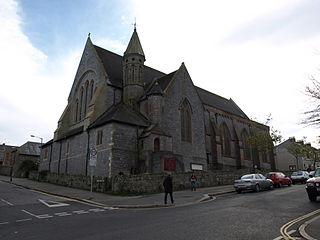
All Saints' Church, Falmouth is a parish church in the Church of England Diocese of Truro located in Falmouth, Cornwall, United Kingdom.
Arnott Maxwell Fernie was a New Zealand organist, teacher and conductor. He was an authority on Gregorian chant, sixteenth century polyphony, organ construction and tonal design.

The Schoenstein Organ at the Conference Center is a pipe organ built by Schoenstein & Co., San Francisco, California located in the Conference Center of the Church of Jesus Christ of Latter-day Saints in Salt Lake City, Utah. The organ was completed in 2003. It is composed of 160 speaking stops spread over five manuals and pedals. Along with the nearby Salt Lake Tabernacle organ, it is typically used to accompany the Tabernacle Choir at Temple Square. Schoenstein & Co.'s president and tonal director, Jack Bethards, describes it as "an American Romantic organ" that is "probably more English than anything else."
The Brindley organ of St Mary's Church, Tickhill, South Yorkshire, England is a Victorian pipe organ influenced by the German organ building tradition.

Casavant Frères Ltée. Opus 1841 is a pipe organ built by the famous Casavant Frères of Saint-Hyacinthe, Quebec. The organ was first completed in 1911 as Casavant Brothers - Opus 452 for St. Andrew's Presbyterian Church at 40 Bentinck Street, Sydney, Nova Scotia, Canada. St. Andrew's later became St. Andrew's United Church and is now the Highland Arts Theatre.

